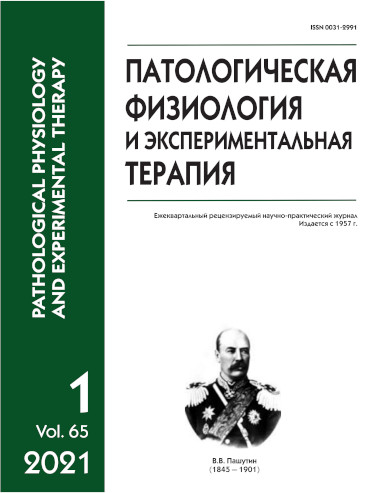Comparative effects of intragastric Lys-Arg-Arg-Lys-Pro-Gly-Pro peptides, warfarin, and acetylsalicylic acid on hemostasis indexes and blood glucose in development of metabolic syndrome in rats
Abstract
Drugs with different structure, carbohydrates, peptides, and proteins, can produce a significant anticoagulation effect and simultaneously improve carbohydrate metabolism. The aim of this study was to compare effects of drugs with different structure, a peptide, a dioxicoumarin derivative, and acetylsalicylic acid (ASA), on coagulation and changes of carbohydrate metabolism in intragastric administration to rats. Methods. Standard methods for studying coagulation and measuring blood glucose in rats were used. Each of the study drugs (Lys-Arg-Arg-Lys-Pro-Gly-Pro peptide, warfarin, and ASA) was administered to Wistar rats intragastrically at an effective dose (100 mcg/kg for the peptide and warfarin and 1 mg/kg for ASA) for 7 days during the development of metabolic syndrome (MS) induced by a high-calorie diet (HCD). Measurements were performed at 20 and 168 h after the last administration of the drugs with continuing HCD. Results. Both at 20 and 168 h after the last administration of the peptide and ASA, platelet aggregation showed a tendency to a decrease and was 72-76% (at 20 h) and 81-66.7% (at 168 h); fibrinolysis significantly increased under the action of the peptide, ASA, and warfarin by 61-180%, 15-41%, and 14-34%, respectively. Activated partial thromboplastin time significantly increased under the action of the peptide and warfarin by 24-52% and 31-52%, respectively; blood clotting as estimated in the prothrombin time test decreased only under the action of warfarin by 12.3%; blood glucose returned to a normal level under the action of each of the three study drugs and was 4.9–6.5 mmol/l vs. 8.1-8.8 mmol/l in MS. Conclusion. The peptide, warfarin, and ASA produced different degrees of the anticoagulation and hypoglycemic effects. The peptide had the strongest anticoagulation and fibrinolytic effects, warfarin produced an anticoagulant effect only according to the prothrombin time test, and acetylsalicylic acid exerted both antiplatelet and fibrin-depolymerizing effects.
Downloads
References
2. Czuprynska J., Patel J.P., Arya R.Current challenges and future prospects in oral anticoagulant therapy. Br J Haematol. 2017;178(6):838-51. doi: 10.1111 / bjh.14714.
3. Capodanno D., Angiolillo D. Aspirin for Primary Cardiovascular Risk Prevention and Beyond in Diabetes Mellitus. Circulation. 2016;134(20):1579-94.
4. Milatová E., Milata V. Warfarin - its synthesis and properties in a twenty-year retrospective. Ceska Slov Farm.2013; 62 (3):111-19.
5. Kimmel S.E. Warfarin pharmacogenomics: current best evidence.
J. Thromb. Haemost.2015; 13.Suppl .1: S266-71. doi: 10.1111 / jth.12978.
6. Mohammad I., Korkis B., Garwood C.L.Incorporating Comprehensive Management of Direct Oral Anticoagulants into Anticoagulation Clinics. Pharmacol.therapy. 2017; 37(10):1284-97. doi: 10.1002 / phar.1991.
7. .Lichtenberger L.M., Vijayan K.V., Are Platelets the Primary Target of Aspirin's Remarkable Anticancer Activity? Cancer Res. 2019; 79(15):3820-23. doi: 10.1158 / 0008-5472.CAN-19-0762. .
8. https://medbe.ru/materials/lekarstva-v-revmatologiiatsetilsalitsilovaya kislota/
9. Kina-Tanada M., Sakanashi M., Arasaki A., Tsutsui M..Long-term dietary nitrite and nitrate deficiency causes metabolic syndrome, endothelial dysfunction, and cardiovascular death in mice. Nihon Yakurigaku Zasshi. 2018; 151(4):148-54. doi: 10.1254 / fpj.151.148.
10. Kostapanos M.S., Florentin M., Elisaf M.S., Mikhailidis D.P. Hemostatic factors and the metabolic syndrome. Curr Vasc Pharmacol. 2013; 11(6):880-905.
11. Lyapina L.A., Grigorieva M.E., Obergan T.Yu., Shubina T.A.Theoretical and practical issues of studying the functional state of the anticoagulant blood system. [Teoreticheskie i prakticheskie voprosyizucheniya funktsional’nogo sostoyaniya protivosvertyvayushchey sistemy krovi]. Moscow: Advanced Solutions. 2012. (in Russian)
12. Kaji H. Adipose Tissue-Derived PlasminogenActivator Inhibitor-1 Function and Regulation. Compr. Physiol. 2016; 6 (4):1873-1896. doi: 10.1002 / cphy.c160004.
13. Wu G., Bazer F.W., Burghardt R.C., Johnson G.A., Kim S.W. , Knabe D.A ., Li P., Li X. , McKnight J.R. , Satterfield M.C., Spencer T.E. Proline and hydroxyproline metabolism: implications for animal and human nutrition. Amino Acids. 2011; 40 (4):1053-63. doi: 10.1007 / s00726-010-0715-Z.
14. Leite P.M., Martins M.A.P., Castilho R.O. Review on mechanisms and interactions in concomitant use of herbs and warfarin therapy.Biomed Pharmacother. 2016; 83: 14-21. doi: 10.1016 / j. biopha.2016.06.012.
15.Michalcová J., Buliková A., Zavřelová J., Prudková M., Penka M. The current role of warfarin.Vnitr Lek. Winter. 2018; 63(12):957-66.
16. Yamagishi S.I.Concerns about clinical efficacy and safety of warfarin in diabetic patients with atrial fibrillation. Cardiovasc Diabetol. 2019; 18 (1):12. doi: 10.1186 / s12933-019-0818-0-да.
17. Vouillarmet J., Aboyans V. Aspirin in people with diabetes: Time to clean up the prescription list? Diabetes Res Clin Pract. 2019;149: 208-09. doi: 10.1016 / j. diabres.2019.02.005.






